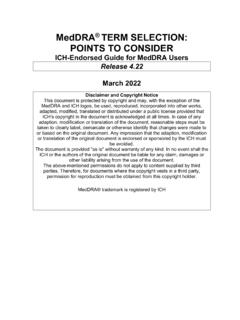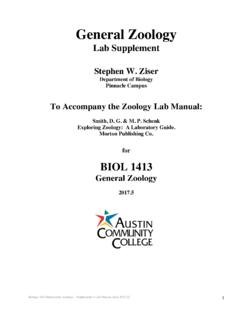Transcription of Introductory Guide MedDRA Version 24
1 Introductory Guide MedDRA Version September 2021 000594 Notice to Reader MedDRA Introductory Guide Version ii September 2021 000594 Notice to Reader This Introductory Guide is written in English and is intended only for use with the English Version of MedDRA . Additional Introductory Guides have been developed to support languages other than English and are included with their specific translation copies. The Introductory Guide is intended for use in conjunction with the MedDRA Browsers, available with each MedDRA subscription. Changes which are Version specific or changes in documentation may be found in the What's New document. This document is included with the MedDRA release and is also posted on the MSSO Web site under Support Documentation. The MedDRA terminology is maintained under an ISO 9001:2015 registered quality management system.
2 * * * Acknowledgements MedDRA Introductory Guide Version iii September 2021 000594 Acknowledgements MedDRA trademark is registered by ICH. The following sources of information are also acknowledged: Diagnostic and Statistical Manual of Mental Disorders, Fifth Edition (DSM-5) Copyright 2013 American Psychiatric Association. ICD-9-CM, International Classification of Diseases, Ninth Revision, Clinical Modification, Copyright 1998 Medicode, Inc. COSTART Thesaurus Fifth Edition, Copyright 1995 US Food and Drug Administration (FDA). Hoechst Adverse Reaction Terminology System (HARTS), Copyright 1992 Aventis Pharma. WHO Adverse Reaction Terminology (WHO-ART), Copyright 1998 World Health Organization Collaborating Centre for International Drug Monitoring.
3 Japanese Adverse Reaction Terminology (J-ART) is a product of the Ministry of Health, Labour and Welfare (MHLW). LOINC is a registered trademark of Regenstrief Institute, Inc. Lanoxin is a registered trademark of GlaxoSmithKline. Merriam-Webster is a registered trademark of Merriam-Webster, Incorporated. Merriam-Webster Online Dictionary copyright 2005 by Merriam-Webster, Incorporated. Dorland's Illustrated Medical Dictionary, copyright 2004, W. B. Saunders, an Elsevier imprint. Disclaimer and Copyright Notice This document is protected by copyright and may, with the exception of the MedDRA and ICH logos, be used, reproduced, incorporated into other works, adapted, modified, translated or distributed under a public license provided that ICH's copyright in the document is acknowledged at all times.
4 In case of any adaption, modification or translation of the document, reasonable steps must be taken to clearly label, demarcate or otherwise identify that changes were made to or based on the original document. Any impression that the adaption, modification or translation of the original document is endorsed or sponsored by the ICH must be avoided. The document is provided "as is" without warranty of any kind. In no event shall the ICH or the authors of the original document be liable for any claim, damages or other liability arising from the use of the document. The above-mentioned permissions do not apply to content supplied by third parties. Therefore, for documents where the copyright vests in a third party, permission for reproduction must be obtained from this copyright holder.
5 Table of Contents MedDRA Introductory Guide Version iv September 2021 000594 TABLE OF CONTENTS 1. INTRODUCTION .. 1 BACKGROUND .. 1 ADOPTION OF MEDICAL TERMINOLOGY AS AN ICH TOPIC .. 2 DEVELOPMENT OF THE MEDICAL DICTIONARY FOR REGULATORY ACTIVITIES ( MedDRA ) TERMINOLOGY .. 2 IMPLEMENTATION OF THE TERMINOLOGY .. 2 SCOPE OF THE TERMINOLOGY .. 3 INCLUSION OF TERMS FROM ESTABLISHED TERMINOLOGIES .. 4 EXCLUSION CRITERIA .. 4 2. STRUCTURAL ELEMENTS OF THE TERMINOLOGY .. 5 EQUIVALENCE .. 5 HIERARCHICAL .. 5 3. LEVELS OF STRUCTURAL HIERARCHY .. 7 LOWEST LEVEL TERMS .. 7 PREFERRED TERMS .. 8 HIGH LEVEL TERMS .. 8 HIGH LEVEL GROUP TERMS .. 9 SYSTEM ORGAN CLASS .. 9 STANDARDISED MedDRA QUERY (SMQ).. 13 4. RULES AND CONVENTIONS ADOPTED IN THE TERMINOLOGY (INCLUDING PRESENTATION AND FORMATTING OF TERMS).
6 14 SPELLING .. 14 ABBREVIATIONS .. 14 CAPITALIZATION .. 15 PUNCTUATION .. 15 SINGLE WORD VS. MULTIPLE WORD TERMS .. 15 WORD ORDER .. 16 MedDRA CODES .. 16 BODY SITE CONSIDERATIONS IN MedDRA .. 16 NUMERICAL VALUES .. 17 Table of Contents MedDRA Introductory Guide Version v September 2021 000594 AGGRAVATION OF UNDERLYING CONDITIONS .. 17 NOS AND NEC TERMS .. 17 GENDER SPECIFIC TERMS .. 17 HIERARCHY NAMING CONVENTIONS .. 18 5. PT AND LLT NAMING CONVENTIONS .. 20 GENERAL WORD USAGE .. 20 GENERAL SEARCH STRATEGIES .. 23 6. SYSTEM ORGAN CLASSES .. 24 BLOOD AND LYMPHATIC SYSTEM DISORDERS .. 24 CARDIAC DISORDERS .. 25 CONGENITAL, FAMILIAL AND GENETIC DISORDERS .. 26 EAR AND LABYRINTH DISORDERS .. 27 ENDOCRINE DISORDERS .. 28 EYE DISORDERS .. 29 GASTROINTESTINAL DISORDERS.
7 30 GENERAL DISORDERS AND ADMINISTRATION SITE 31 HEPATOBILIARY DISORDERS .. 32 IMMUNE SYSTEM DISORDERS .. 33 INFECTIONS AND INFESTATIONS .. 34 INJURY, POISONING AND PROCEDURAL COMPLICATIONS . 36 INVESTIGATIONS .. 38 METABOLISM AND NUTRITION 40 MUSCULOSKELETAL AND CONNECTIVE TISSUE DISORDERS .. 41 NEOPLASMS BENIGN, MALIGNANT AND UNSPECIFIED (INCL CYSTS AND POLYPS) .. 42 NERVOUS SYSTEM DISORDERS .. 44 PREGNANCY, PUERPERIUM AND PERINATAL 45 PRODUCT ISSUES .. 47 PSYCHIATRIC 49 RENAL AND URINARY DISORDERS .. 50 Table of Contents MedDRA Introductory Guide Version vi September 2021 000594 REPRODUCTIVE SYSTEM AND BREAST DISORDERS .. 51 RESPIRATORY, THORACIC AND MEDIASTINAL DISORDERS .. 52 SKIN AND SUBCUTANEOUS TISSUE DISORDERS .. 53 SOCIAL CIRCUMSTANCES.
8 54 SURGICAL AND MEDICAL PROCEDURES .. 55 VASCULAR DISORDERS .. 57 APPENDIX A: ACRONYMS .. 58 APPENDIX B: MedDRA CONCEPT DESCRIPTIONS .. 60 LIST OF TABLES Table 3-1. The MedDRA Terminology SOC List Alphabetical Listing .. 11 Table 3-2. The MedDRA Terminology SOC List Internationally Agreed Order .. 12 LIST OF FIGURES Figure 2-1. Structural Hierarchy of the MedDRA Terminology .. 6 Introduction MedDRA Introductory Guide Version September 2021 000594 1 1. INTRODUCTION The Medical Dictionary for Regulatory Activities ( MedDRA ) Terminology is the international medical terminology developed under the auspices of the International Council for Harmonisation of Technical Requirements for Pharmaceuticals for Human Use (ICH). This Guide describes the development, scope, and structure of the terminology.
9 BACKGROUND Prior to the development of MedDRA , there had been no internationally accepted medical terminology for biopharmaceutical regulatory purposes. Most organizations processing regulatory data used one of the international adverse drug reaction terminologies in combination with morbidity terminology. In Europe, most of these organizations used a combination of the World Health Organization's Adverse Reaction Terminology (WHO-ART ) and the International Classification of Diseases Ninth Revision (ICD-9). In the United States, the Food and Drug Administration's (FDA) Coding Symbols for a Thesaurus of Adverse Reaction Terms (COSTART ) was usually used in conjunction with Clinical Modification of ICD-9 (ICD-9-CM ). The Japanese developed their own versions of these international terminologies, Japanese Adverse Reaction Terminology (J-ART) and Medical Information System (Japan) (MEDIS).
10 In addition, many organizations modified these terminologies to suit their needs. Established terminologies lacked specificity of terms at the data entry level, provided limited data retrieval options ( , too few levels in the hierarchy, or capacity to retrieve data via one axis only), and did not handle syndromes effectively. Organizations with sufficient resources developed their own in-house terminologies to address some or all of these deficiencies. The use of multiple terminologies raised several problems. Using different terminologies at various stages in a product's life complicates data retrieval and analysis, making it difficult to cross-reference data. For example, safety data had frequently been classified for pre-registration clinical trials using ICD terminology and for post-marketing surveillance using J-ART, WHO-ART, or COSTART.






